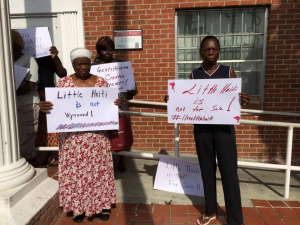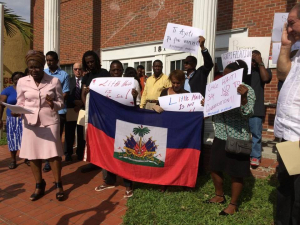Longtime residents, business owners and civic leaders gathered in Miami’s Little Haiti neighborhood on Thursday to deliver a message about their rapidly changing community: “We want to stay.”

Little Haiti residents say investors and real estate developers are buying property and pushing out the people and small businesses that give the district is distinct Caribbean flavor. (Photo Credit: Daniel Chang, The Miami Herald)
Residents and activists, many carrying hand-written signs declaring “Little Haiti is not for sale” and “Say no to gentrification,” said real estate developers and speculators are buying up land and pushing out the people and small businesses that give the neighborhood its distinct Caribbean character.
“They tried to push me out of this area,” said Wilfrid Joseph Daleus, a Haitian immigrant and owner of the Daleus Museum and Art Gallery on 59th Street and Northeast Second Avenue.
Daleus, 66, said he opened his art gallery in 1980 and loves the neighborhood. But his rent is rising, and he feels that local government could do more to help, such designating the area a historic or cultural district.
“The price goes up every month,” Daleus said, “and I don’t have the support to stay. … But I don’t want to go. I want to stay.”
The Little Haiti neighborhood of Miami — an area broadly defined as running from 38th Street to 79th Street between Interstate 95 and the Florida East Coast Railway — does not have an official boundary, though city commissioners have considered a formal designation in the past.
Little Haiti gained its name as Haitian migrants, fleeing the regime of Jean Claude “Baby Doc” Duvalier, began to populate the neighborhood in the late 1970s and early 1980s.

Longtime residents, business owners and civic activists gathered to protest what they see as the gentrification of Little Haiti. They produced a list of demands, including the creation of a cultural district and the establishment of a trust to preserve and acquire land in the district for housing and businesses (Photo Credit: Daniel Chang, The Miami Herald)
Lately, though, art galleries have moved north from Wynwood in search of more affordable rents in Little Haiti. And developers have taken increasing interest in the area, using harassment, intimidation and sometimes inducements to coerce longtime residents and businesses to move, said Marleine Bastien, executive director of Haitian Women of Miami, a community group.
Bastien told a group gathered in front of the offices of the Haitian American Community Development Corporation on Northeast 82nd Street that “a lot of investors and developers are “organizing to change the name of Little Haiti. They are buying left and right, cash. The Little Farm Mobile Court on Biscayne Boulevard, home to many Haitian immigrants, has been purchased through lawyers by a Chinese investor who doesn’t even live here.”
Joined by representatives from local civic groups and elected officials, including Michael Etienne, city clerk for North Miami, Bastien presented a list of demands for Miami leaders, including the creation of a historic or cultural district and the establishment of a community land trust to preserve existing land and acquire new property for housing and small businesses.
She called for fast action from Keon Hardemon, a Miami commissioner whose district includes the Little Haiti neighborhood. “If he doesn’t act,” she said, “soon Little Haiti will disappear.” Hardemon did not respond to an interview request from the Herald made through his chief of staff on Thursday.
Miami Mayor Tomás Regalado said the city has never designated any area in honor of any immigrant group, including Little Havana. But, he said, that doesn’t mean Miami has overlooked the contributions of immigrant groups that have contributed to the city’s history.
“The Haitian heritage can never be erased from the history of Miami,” Regalado said. “It’s still there in Little Haiti, although some Haitians have moved, but still we have the Little Haiti Soccer Park. We have the Little Haiti Cultural Center. We have the Caribbean Marketpalce.”
Source: Miami Herald

